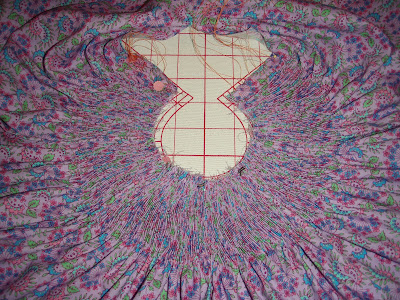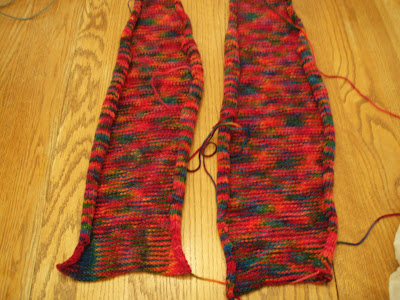So I slid out of the bed at dawn-thirty this morning, threw back a pot of coffee, shaved my ankles in the shower and rubbed a handful of mousse in my hair. I painted my face up and put on A Dress. And instantly, miraculously, I was
ON for another school year. I attribute this to the Wearing Of A Dress, of course.
It was a really good day. By the time I arrived the sunbeams were beaming and so were the faces of my co-workers. I can tell already that we are going to have another great year. Excitement can be very contagious.
And all day, in the back of my mind, was
Woodstock. For I knew, just as surely as I know that the freshmen won't be able to remember their locker combinations, that she was waiting for me to come home.
To refresh your memory, I'm using Jamie by the Childrens Corner, View D, for this little bishop bubble:

Even though technically this is
not A Dress, for all intents and purposes we will forthwith consider it to be such. Case dismissed.
Figuring out which pattern pieces to use is quite a challenge. Just in case you're planning to make this particular view, I'll make it easy for you. There are just three--front, back, and sleeve.
Before I could do any actual cutting, I had to put in some thinking time. I had heard rumors that this pattern ran extremely short in the crotch length, so I checked out the pattern itself. Compared to other bubbles currently living in the vicinity, it
was short. So I consulted the blog world for input. I was advised that it was in fact short (thanks, megsmocks!), so I lengthened the front and back on the shorten/lengthen lines. (Note to myself: Self, if you ever go into the pattern making business, be sure to place the shorten/lengthen lines in the same location on adjoining pattern pieces. Don't make sewing any more challenging than it already is.)
Since I added one and a half inches to the crotch length, that should take care of any possible crotch shortness problems. But I like to have backup plans, and here they are:
- The crotch length will be perfect, and I will smile.
- The crotch length will be too long, and I will smile.
- The crotch length will still be too short, and I will smile.
Case 1 above will make me smile because I avoided a problem.
Case 2 above will make me smile because I can add tucks to take up any extra length.
Case 3 above will make me smile because I will have tried my best to make this work, even though I didn't get the desired results. If this scenario develops, I will just cut the darn thing off and it will become a bishop bubble top.
I couldn't get both the front and back pieces in the next photo, but I'm hoping it will explain that little note to myself I wrote above. Although it really won't make a hill of beans in the end, it would have been more convenient if the shorten/lengthen lines were at the same level on the front and back pieces. Since there is the probability that some of the extra length I added might need to be tucked out, I wanted to mark my fabric so I would have an even, straight line all around the lower body to use as a starting point for those tucks. The easiest time to mark this is before I sew the thing together. The shorten/lengthen lines would have been the most logical (and easiest) place to do that, but they didn't correlate to each other.
You can see where I had to draw my tuck lines in the photo (I measured up 3 inches from the bottom of the side seam and marked the fabric front and back on the right side. When the bubble is sewn together, I will end up with a continous tuck line all around the body).

So those are my just-in-case lines if problem 2 develops. If I don't need them I will use my voodoo powers to make those lines disappear. Here's a better shot to help you see through all this mud I am trying to describe:

The most problematic part of making a smocked bubble is getting it to go through the pleater. After much study and even more aggravation I have hit on a method that eliminates this headache.
The first step is to examine the seams on the front, back, and sleeve pattern pieces. This is a photo of the sleeve pattern piece. Can you see how that seam is straight at the top (where I am measuring) and then it begins to flare out a bit?

That flare is what causes all the pleating problems. It is high near impossible to roll a bishop neckline evenly on a Magic Stick because that flare prevents the fabric from rolling in the way it needs to roll. So I measure the straight part of that sleeve seam because that part of it will feed through the pleater easily.
I consult my smocking pattern and see that I will need to pleat six rows. Then I measure my pleater to see if the six rows and the top seam allowance will fit within that straight part of the seam:

In my case it will, so I do a quick tap dance.
But what if it won't? Since different brands of pleaters have different spacing between the needles (my two do), you may have to adjust something. When this happens to me, I take my pencil and straighten out that flare in the sleeve. Headache avoided.
Here's another photo--in this one I am comparing the pattern to the pleater:

If you have a question, please ask. This was difficult to explain but easy to do.
And let me just add this Official Disclaimer:
I am not and never will be a sewing/smocking/pleating expert. I am an old dog who is willing to learn new tricks, so if you can offer some up, please do so.
More mish-mash to come.



















































